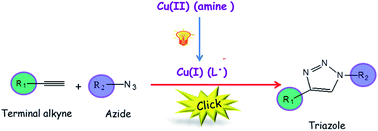Evaluation and development of novel photoinitiator complexes for photoinitiating the copper-catalyzed azide–alkyne cycloaddition reaction
Abstract
Here, several distinct approaches for photoinitiation and subsequent utilization of the Copper catalyzed azide–alkyne cycloaddition (CuAAC) reaction are developed. In particular, Cu(II)–ligand complexes were synthesized that enabled direct photoreduction of the Cu(II). The sequential and orthogonal nature of the photo-CuAAC reaction and a chain-growth acrylate homopolymerization were demonstrated and used to form branched polymer structures. The efficiency of the photo-initiated Cu(II) complexes in regard to their ability to initiate the CuAAC reaction was examined by reacting a variety of amino-functional ligands with Cu(II) halides to form complexes capable of forming Cu(I) upon light irradiation. When irradiated with 365 nm light, the ligand donates an electron to Cu(II) to reduce it to Cu(I) which subsequently initiates the azide–alkyne cycloaddition (i.e., photo-CuAAC) reaction with exquisite spatiotemporal control. Aliphatic amine ligands were found to be the most efficient ligands in promoting photoreduction of Cu(II) and stabilizing Cu(I), once formed. Among the aliphatic amines studied, tertiary amines such as triethylamine (TEA), tetramethylethylenediamine (TMDA), N,N,N′,N′′,N′′-pentamethyldiethylenetriamine (PMDTA), and hexamethylenetetramine (HMTETA) were found to be the most effective. In addition, the Cu(II)–amine complexes were insensitive to oxygen, indicating that the catalytic Cu(I) is largely prevented from re-oxidation by complexation with the amine ligand and/or the triazole. The reaction kinetics were accelerated by increasing the PMDETA : Cu(II) ratio with a ratio of ligand to Cu(II) of 4 : 1 yielding the maximum conversion in the shortest time.


 Please wait while we load your content...
Please wait while we load your content...